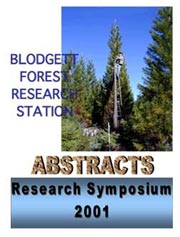ABSTRACT 2
Understory Light climates at Blodgett Forest: Shadelight influences on sapling growth and morphology
John J. Battles
Environmental Science, Policy, and Management, University of California, Berkeley, 151 Hilgard Hall, Berkeley, CA 94720-3110, (510) 643-0684, jbattles@nature.berkeley.edu
|
|
|
Results from an array of studies at Blodgett Forest were summarized in order to describe the broad gradient of light environments maintained by the current management regime and to correlate the quantity and quality of the light resource to plant form and function. It is an axiom of ecological understanding that trees in productive forests must grow tall in order to survive and reproduce. Thus, competition for light is often considered the key biological process that structures forest communities. Consequently I expected to find morphological responses as well as growth responses to differences in the light climate. In particular, saplings in more shaded understories should express a "shade morphology" in addition to lower overall growth rates.

I quantified morphological patterns by calculating the root weight ration (RWR:root weight/total sapling weight) and the branch length ratio (BLR: sum of all the lateral branch lengths/total stem length). Low RWR and BLR indicate shade morphologies (more allocation to stem growth over root and branch growth). I examined three conifer species native to these forests: Douglas-fir, sugar pine, and ponderosa pine. Light climates were characterized with hemispherical photography calibrated with detailed direct measures of photon flux. Light quality was expressed as the ratio of red light to far-red light (R:FR) based on repeated instantaneous spectral scans of incident radiation taken with 2 hours of solar noon. R:FR values below 0.8 can induce a shade-response.
As designed, management regimes created a significant gradient in understory light climates. In the interior of one ha groups, 89% of the incident radiation reached the understory compared to only 12% under reserve stands. Interestingly, single-tree selection created canopy openings that received significantly more light than the average "natural" gap in the reserve stands (28% vs 20%). For all three species, relative height growth was positively correlated with transmitted radiation. Douglas-fir and sugar pine demonstrated strong morphological responses to shadelight with lower relative allocation to roots and branches in the more shaded environments. In contrast, ponderosa pine showed no consistent allometric differences to increased shadelight. A study is underway to test experimentally these observed patterns.
Table 1. Summary of the light regime in the contrasting understory environments at Blodgett Forest. Reported values are means with standard deviations in parentheses. Light regime summarized for the growing season: 5/1 to 8/31.
|
Comp
|
n
|
Open Sky
%
|
Total Radiation
%
|
Direct Beam
%
|
Over head R:FR
|
Reflected
R:FR
|
| Group selection |
|
|
|
|
|
|
|
|
1 ha groups
|
20, 40 |
15 |
56 (6) |
89 (4) |
93 (4) |
> 1.0 |
0.45 (0.06) |
|
matrix
|
20, 40 |
8 |
12 (4) |
12 (7) |
15 (5) |
-- |
-- |
| Shelterwood |
440 |
20 |
38 (3) |
59 (12) |
61 (14) |
~1.0 |
0.46 (0.09) |
| Single-tree openings |
130 |
12 |
17 (13) |
28 (21) |
30 (22) |
-- |
-- |
| Reserve |
|
|
|
|
|
|
|
|
grid
|
220 |
16 |
8 (3) |
12 (6) |
12 (7) |
0.75 (0.3) |
0.58 (0.1) |
|
grid
|
292 |
16 |
7 (2) |
13 (4) |
14 (5) |
0.65 (0.4) |
0.33 (0.2) |
|
gaps
|
220, 292 |
14 |
10 (3) |
20 (7) |
21 (9) |
0.90 (0.3) |
0.38 (0.1) |
| Above canopy reference |
BFRS |
-- |
100 % |
625
(µmols m-2 s-1)
|
468
(µmols m-2 s-1) |
1.1 |
0.9 |
Table 2. Morphology and growth of tree seedlings along a gradient of understory environments at Blodgett Forest. Species codes: DF = Douglas-fir; SP = sugar pine; PP = ponderosa pine. Reported values are means with standard deviations in parentheses.
|
Root Weight Ratio
(root mass/total mass)
|
Branch Length Ratio
(branch length/stem length)
|
Relative Height Growth
(%)
|
|
Environment
|
DF |
SP |
PP |
DF |
SP |
PP |
DF |
SP |
PP |
|
1 ha groups
|
0.42
(0.02) |
-- |
0.28
(0.03) |
11.0
(1.6)
|
3.60
(0.92) |
0.355
(0.46) |
0.567
(0.099) |
-- |
0.315
(0.20) |
| Shelterwood |
-- |
0.28
(0.05) |
-- |
-- |
2.71
(1.4) |
-- |
-- |
0.297
(0.194) |
-- |
| Single-tree openings |
0.39
(0.05) |
-- |
0.38
(0.04) |
3.39
(1.83) |
-- |
0.466
(0.62) |
0.218
(0.16) |
-- |
0.214
(0.21) |
| Reserve gaps |
0.32
(0.1) |
-- |
-- |
1.01
(0.66) |
0.426
(0.46) |
-- |
0.163
(0.21) |
0.0960
(0.17) |
-- |
|


